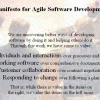 |
Build One before Building Many: Learning from Agile Feedback When you're working on a project and are presented with a big story or requirement, resist the urge to treat it as a single piece of work. One of the principles of the Agile Manifesto is to deliver working software frequently. This allows you to learn from what you built and make adjustments. See if you can break down the request and find a small piece of work within the big.
|
|
 |
7 Lessons Agile Can Teach Us about Leadership The Agile Manifesto contains values to guide teams toward developing better software. But its directives are also about leadership—influencing culture and creating an organization where people can collaborate to meet the needs of their customers. Here are seven lessons the Agile Manifesto can teach us about leadership.
|
|
 |
The Transparency Experiment: Improving Accuracy and Predictability in Scrum Using the iterative and incremental agile development framework Scrum should help manage product development, but some teams still have difficulty delivering features in a predictable manner. This organization decided to address the mismatch between what was being committed and what was accomplished by doing an experiment in work transparency.
|
|
 |
Reduce Uncertainty in Agile Projects with #NoEstimates Thinking Estimation uncertainty in software projects is often not driven by the difficulty of the problem we are trying to solve, but rather by the health of our codebase, the quality of process, and how much discipline we have in our management practices. If you want to improve your estimates, then agile and #NoEstimates thinking can have the biggest impact on your team’s success.
|
|
 |
Let the Agile Manifesto Guide Your Software Testing Although its values are commonly associated with agile software development, the Agile Manifesto applies to all people and teams following the agile mindset, including testers. This article examines the four main values of the Agile Manifesto and reveals how they can bring agility to test efforts—improving quality for your team and your customers.
|
|
 |
Building Team Relationships as an Agile Coach Only by creating a relationship based on trust can agile coaches be effective in aiding teams with an agile adoption. Joel Bancroft-Connors says the best start is actually to do nothing. Spend time observing the team first. This helps you understand the people and processes, which will help you determine the best course of action.
|
|
 |
Delivering Value with Agile and #NoEstimates #NoEstimates is a challenge to the traditional thinking that estimation is essential to agile development. Ryan Ripley believes there are more interesting tools available to help us determine what value is and when we could realize it, while still staying aligned with the businesses and customers we serve. Learn some other ways to deliver value to your customers.
|
|
 |
The Agile Cookbook: Recipes for Enterprise Agile Transformations Scaling agile across a large, enterprise organization is different from dealing with just a handful of teams. Though you have the same key ingredients, there are several recipes for how to put those ingredients together. Enter The Agile Coach’s Transformation Cookbook. You can whip up an organization-wide agile transformation by finding your own recipe for success.
|
|
 |
Agile Techniques for the Multitaskers in All of Us Multitasking can sabotage your productivity, but with all our different responsibilities, it's often a necessary evil. However, your work quality and quantity don’t have to suffer. These agile techniques can help you avoid interruptions, organize your to-do list, and regain focus after switching tasks.
|
|
 |
Instead of MVPs, Maybe We Should Be Releasing SMURFS The term minimum viable product, or MVP, has come to be misunderstood and misused in many organizations. It doesn’t mean you should be releasing half-baked, barely feasible software. Instead, you should be thinking of your product’s capabilities as a Specifically Marketable, Useful, Releasable Feature Set—or SMURFS!
|
|

